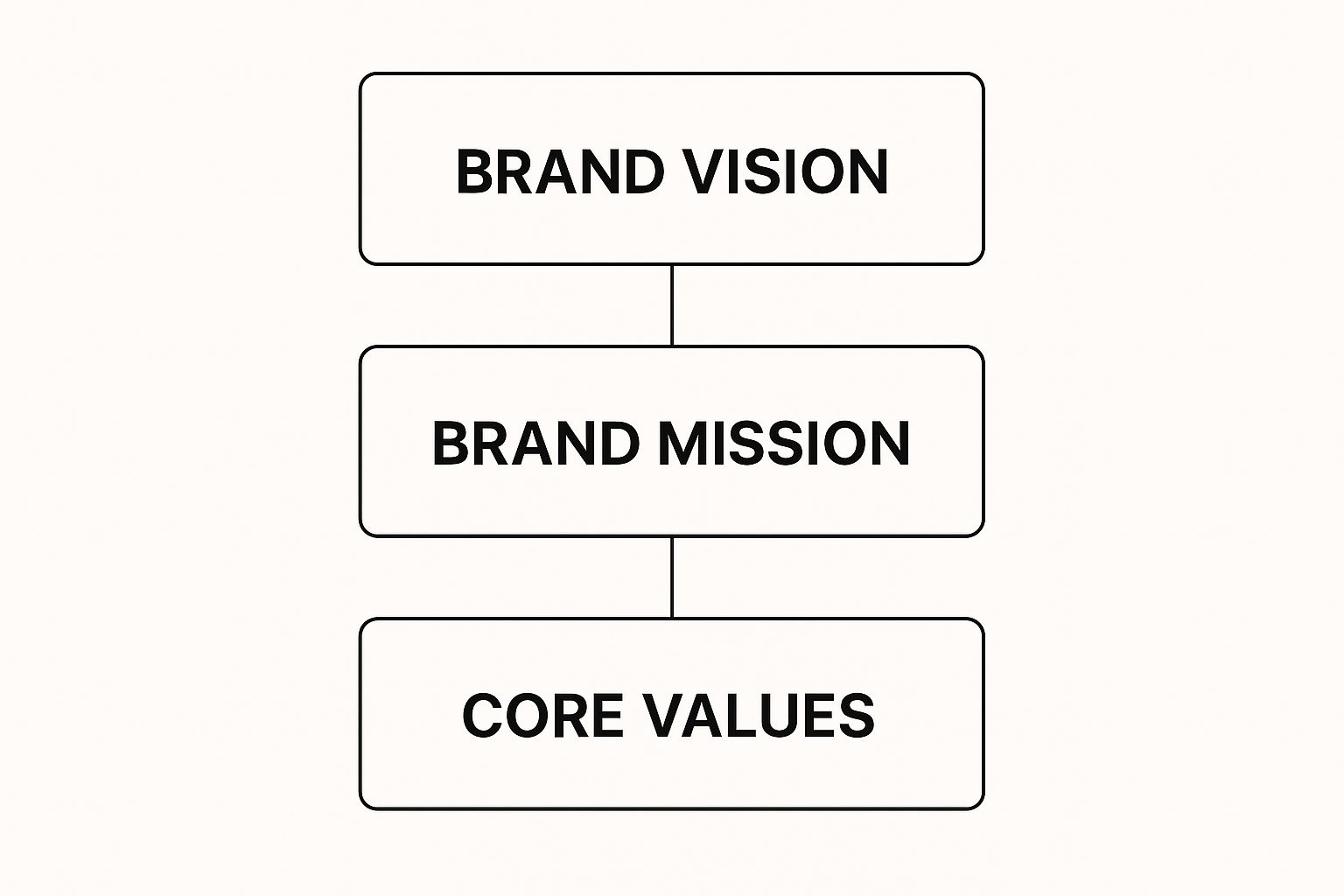A solid social media branding guide isn't just about picking pretty colors and a cool logo. It’s your playbook for creating a distinct, memorable personality for your business online. Think of it as defining who you are, what you sound like, and the unique vibe you give your followers. In a space as noisy as social media, a strong brand is what makes you recognizable and, more importantly, trustworthy.
What Is Social Media Branding and Why Does It Matter?
Let's break it down. Your brand is your business's personality. Social media branding, then, is how you let that personality shine across platforms like Instagram, LinkedIn, and TikTok. It’s the consistent story you tell through your visuals, the tone of your captions, and every single comment, reply, and DM. Without it, you’re just shouting into the void.
This consistent identity is what separates brands that stick from ones that are instantly forgotten. When you get it right, you build a powerful sense of familiarity and trust. People will start to recognize your content in their feed at a glance, even before they see your profile picture. That’s how you start turning casual scrollers into a real community of fans who actually care about what you do.
The Foundation of Your Brand
Before you can even think about posting, you have to nail down your core identity. This whole process begins with getting crystal clear on your brand's purpose—the big "why" that drives your business. That "why" becomes the North Star that guides every piece of content you create.
This hierarchy is a great way to visualize how your big-picture vision and mission trickle down into tangible core values that shape your day-to-day social media activities.

When you have this structure in place, you can be confident that everything you post is intentional and reinforces a consistent brand strategy.
Your Opportunity in a Connected World
The sheer scale of social media is staggering, and that presents a massive opportunity for any business. As of early 2025, there are about 5.24 billion active social media users across the globe. That's nearly 64% of the world's population. This incredible reach, detailed in reports from sources like DataReportal.com, makes these platforms the most direct way to connect with customers right where they are.
But a strong social media brand does so much more than just reach people; it builds genuine connections that fuel real business growth.
A brand is no longer what we tell the consumer it is—it is what consumers tell each other it is. Your social media presence is the primary stage where these conversations happen.
Smart branding ensures those conversations are positive, reflect your values, and build a reputation you can be proud of. Building a brand is truly the fastest path to public recognition, and it all starts with a clear, strategic plan. For a deeper dive, check out our guide on brand building on social media.
Let’s quickly summarize the core pillars that hold up a strong social media brand.
The Pillars of a Strong Social Media Brand
These core components work together to build a cohesive and memorable brand identity across all social platforms.
| Pillar | Description | Key Action |
|---|---|---|
| Brand Voice | The distinct personality and tone your brand uses in all communication. | Define your brand archetype (e.g., The Sage, The Jester) and create clear voice guidelines. |
| Visual Identity | The consistent look and feel of your brand, including logos, colors, and fonts. | Develop a visual style guide with color palettes, typography, and image standards. |
| Content Strategy | The plan for what you post, focusing on topics that serve your audience. | Identify content pillars that align with your expertise and your audience's interests. |
| Community Engagement | How you interact with your audience through comments, DMs, and shares. | Establish a proactive and authentic approach to conversations with your followers. |
Ultimately, investing time and effort into your social media brand is a direct investment in your business’s future. It's how you build:
- Recognition: Becoming that one brand people instantly identify in a crowded feed.
- Trust: Showing up consistently and authentically, which proves to your audience you’re the real deal.
- Loyalty: Creating an emotional connection that turns followers into your biggest cheerleaders.
How To Define Your Brand Voice And Personality

If your brand were a person, what would they sound like? That’s the real question behind what we call “brand voice.” It’s not just about what you say, but how you say it. This is the unique personality that comes through in every single caption, comment, and DM you send. It’s what makes your brand feel human.
Think of it this way: two different friends can tell you the same piece of news, but how they tell it creates two totally different experiences. One might be straight-faced and serious, while the other is animated and cracking jokes. Your brand voice is that delivery—it’s the distinct flavor that sets you apart and makes people feel something when they see your posts.
When you don't have that consistency, things get confusing. One day you’re posting a stiff, corporate-sounding update, and the next you’re dropping a random meme. That kind of back-and-forth makes your audience feel like they don't really know who you are, which chips away at their trust.
Discovering Your Brand Archetype
A fantastic way to start pinning down your voice is by looking at brand archetypes. These are basically universally understood characters or personalities that can give your brand a familiar feel right out of the gate. Are you the wise Sage, the rebellious Outlaw, the nurturing Caregiver, or the witty Jester?
Picking an archetype gives you a solid foundation to build from. It acts as your brand’s North Star, guiding your tone of voice, the words you choose, and even your sense of humor.
To figure out which one fits you best, gather your team and ask these questions:
- If our brand walked into a room, what three words would describe it? (e.g., "Warm," "innovative," "bold")
- What’s our relationship with our customers? Are we their mentor? Their sidekick? A supportive coach or a close friend?
- How do we want our audience to feel? Should they feel inspired, secure, entertained, or educated after reading our content?
- Which brands do we really admire, and what is their personality like? This helps you see what kind of voice resonates with you and your team.
Working through these questions will almost always point you toward an archetype that feels genuine and true to your business. This is the difference between a brand that just sells things and one that actually stands for something.
Your brand voice is the soul of your content. It’s the invisible thread that connects your mission to your audience, turning a simple post into a memorable interaction. It’s what makes people not just follow you, but feel like they know you.
Once you’ve got that core personality figured out, it’s time to create a guide for your team.
From Archetype To Actionable Guidelines
Now, let's turn that personality into a set of clear, practical rules. This is crucial for making sure everyone—from your social media manager to your customer service reps—is speaking with the same consistent voice.
Your brand voice guide should cover a few key areas:
- Tone: Nail down the specific attitudes your brand can express. For example, a "Friendly & Encouraging" voice might have tones that are inspiring, positive, and supportive. The "don'ts" are just as important—so you’d want to avoid being patronizing or childish.
- Vocabulary: What words are "on-brand" for you, and which ones should you avoid? A tech company might lean into words like "optimized" and "integrated," while a wellness brand would probably prefer "holistic" and "nourishing." You should also have a clear stance on using (or avoiding) industry jargon.
- Grammar & Punctuation: Are you casual enough to use sentence fragments for a punchier feel? Do you have strong feelings about the Oxford comma? Are exclamation points something you use freely, or do you save them for truly big announcements?
- Emoji & GIF Usage: This might seem small, but it matters! Define which emojis fit your brand’s vibe and how often they should pop up. For instance, LinkedIn's voice is professional and authoritative, so you won’t see them using the 🤪 emoji. On the other hand, Duolingo's playful and slightly unhinged personality means they use them all the time.
By creating these simple guardrails, you build a brand personality that people can recognize and trust. That consistency is what a powerful social media branding strategy is all about.
Creating A Cohesive Visual Identity For Social Media
If your brand voice is what you sound like, then your visual identity is what you look like. Think of your visuals as a silent handshake—they make an immediate impression, often before your audience reads a single word. In a world of endless scrolling, a strong, consistent look is what makes people stop and recognize your content instantly.
This goes way beyond just your logo. It’s about the entire aesthetic atmosphere you build around your brand. When you nail this consistency, you build familiarity and trust. It signals that you’re professional, polished, and have a clear purpose.
The Core Elements Of Your Visual Brand
Your visual identity is really a recipe made from a few key ingredients. Each one brings its own flavor, and when they all work together, the result is something memorable and distinct.
Let’s break down the most important components:
- Color Palette: Colors speak a language all their own, stirring up emotions without you even realizing it. You'll want to pick a primary palette (2-3 main colors) and a secondary one (1-2 accent colors) that genuinely reflect your brand's personality. Are you energetic and bold? Think reds and yellows. Calm and trustworthy? Blues and greens are your friends.
- Typography: The fonts you use say more than you think. A sleek, modern sans-serif font can feel clean and direct, while a traditional serif font might communicate experience and authority. Stick to one or two primary fonts for your headings and body text to keep things looking clean and consistent.
- Logo Usage: Your logo is your signature, but how and where you use it is crucial. It's a cornerstone of your visual identity on social media, so you need to think about how it'll look in different spots, like this example of a cropped logo. You'll need different versions ready for profile pictures, post watermarks, and cover banners.
- Image and Imagery Style: What's the vibe of your photos and graphics? Are they going to be bright and airy, or dark and moody? Will you focus on people, products, or more abstract designs? Deciding on a consistent editing style—like always using the same filter or preset—is the glue that holds all your visual content together.
These elements combine to create your brand's "uniform," making every single post feel like it belongs to the same family.
Building Adaptable Templates
Let’s be real: trying to create a brand-new, unique post from scratch every single day is a fast track to burnout. It's just not efficient. This is where templates become your absolute best friend. They are simply pre-designed layouts that you can quickly drop your content into.
A great template is a framework, not a cage. It provides structure and brand consistency while still allowing for creative freedom. The goal is to be recognizable, not repetitive.
You'll want to design templates for your most common post types on each platform:
- Instagram: Create templates for your feed posts, Stories, and Reels covers.
- LinkedIn: Have templates ready for article banners, text posts with branded backgrounds, and company updates.
- TikTok & Reels: Design templates for your video intros, outros, and any on-screen text to ensure they use your brand fonts and colors.
Tools like Canva or Figma make it incredibly easy to create a whole library of these templates. This system empowers anyone on your team to whip up on-brand content in minutes, saving a ton of time and preventing visual slip-ups.
Aligning Your Video Content
Video isn't just a "nice-to-have" anymore; it’s a central part of how brands connect with their audiences today. The proof is in the numbers. Digital video advertising is projected to leap from $104.65 billion in 2024 to an estimated $140.18 billion in 2025. It's pretty clear where the focus is shifting. In fact, research shows that 78% of people would rather learn about a new product by watching a short video.
To keep your branding tight, your video style has to be in sync with your overall visual identity. This means paying attention to:
- Consistent Editing: Does your video editing match your brand's energy? A high-energy brand might use fast-paced cuts, while a more thoughtful brand could use a slower, more cinematic style.
- On-Screen Graphics: Any text, captions, or graphics that pop up on screen need to use your designated brand fonts and color palette. No exceptions.
- Thumbnails and Covers: Your thumbnail is the movie poster for your video—it’s often the first thing people see. Make sure it’s designed with your brand templates to create a clean, uniform look on your profile grid or YouTube channel.
When you apply your visual identity to every format, from a simple static image to a dynamic video, you build a powerful and memorable brand presence that literally stops the scroll.
Building Your Social Media Content Strategy

So, you've nailed down a powerful brand voice and a killer visual identity. That's fantastic, but it's only half the battle. Without a smart plan for what you’ll actually post, even the best branding falls flat. A content strategy is the essential bridge connecting your brand identity to your real-world business goals.
Think of it as your blueprint for creating consistent, purposeful content that does more than just fill a feed—it builds your brand and gets you tangible results. Without a strategy, you’re just posting on a whim, scrambling for ideas, and watching opportunities to connect with your audience fly by. A solid plan transforms your social channels from a chaotic chore into one of your most powerful brand-building assets.
Establish Your Content Pillars
The bedrock of any great content strategy is a set of content pillars. These are the handful of core topics or themes your brand will own and talk about, day in and day out. They’re the subjects you want to be known for—the sweet spot where your expertise meets your audience's interests.
For example, a fitness brand might build its strategy on pillars like "Workout Tutorials," "Healthy Recipes," and "Mindfulness Tips." A SaaS company could focus on "Productivity Hacks," "Industry News," and "Customer Success Stories." By choosing 3-5 core pillars, you create an incredibly effective filter for your content ideas. Every single post should tie back to one of these pillars, keeping your feed focused, relevant, and consistently on-brand.
This simple framework saves you from chasing random trends that don’t serve your mission, ensuring every piece of content reinforces who you are and what you offer.
To show you what this looks like in practice, here's a sample framework for a fictional wellness brand.
Example Content Pillar Framework
| Content Pillar | Brand Goal | Example Post Idea 1 | Example Post Idea 2 |
|---|---|---|---|
| Mindful Mornings | Promote a calm, intentional lifestyle | A carousel post on "5 Ways to Start Your Day Without Your Phone" | A short video of a simple 2-minute breathing exercise |
| Nutrient-Dense Foods | Educate on the power of whole foods | An infographic showing the benefits of Vitamin D | A recipe Reel for a "Brain-Boosting Smoothie" |
| Sustainable Living | Connect with eco-conscious consumers | A story poll asking, "What's your favorite reusable product?" | A blog post feature on "How to Reduce Kitchen Waste" |
As you can see, these pillars generate a nearly endless stream of on-brand ideas that genuinely serve their audience while reinforcing what the brand stands for.
Create A Balanced Content Mix
Here's a hard truth: not every post can be about making a sale. In fact, a feed filled with constant "buy now!" messages is the fastest way to get unfollowed. A successful social media strategy always champions a balanced mix of content types, meeting people where they are.
An effective and time-tested approach is the 80/20 rule:
- 80% of your content should give value. This is your chance to educate, entertain, inspire, or solve a problem for your audience—no strings attached. It's all about building relationships and earning trust.
- 20% of your content can be promotional. This is where you can comfortably talk about your products, share a special offer, or guide people toward making a purchase. Since you've spent the majority of your time being helpful, these posts feel earned, not sleazy.
Your goal on social media is to build a community, not just collect an audience. Give, give, give, and then ask. This generosity is what turns followers into loyal customers who believe in your brand.
This balance makes your feed feel like a valuable resource, not a digital billboard. Mapping this out is a crucial part of the process, and you can learn exactly how to create a social media plan to structure your entire content framework.
Plan With A Content Calendar
A content calendar is where your strategy comes to life. It’s a simple schedule that dictates what you'll post, on which platform, and at what time. This tool is non-negotiable for staying consistent, planning for big launches, and making sure your whole team is on the same page.
Your calendar can be a straightforward spreadsheet or a more sophisticated tool like Asana or Trello. The format doesn't matter as much as the function. The key is to plan your posts at least a few weeks out, including details like:
- The exact date and time for publishing
- The social media network
- The content pillar it supports
- The final copy, visuals, and any relevant links
Planning ahead with a calendar turns social media management from a daily panic into a smooth, well-oiled machine. It also gives you a bird's-eye view of your content, helping you spot any gaps and ensure you're maintaining that crucial 80/20 balance. This foresight is what allows you to create high-quality, on-brand content, every single time.
How To Engage Your Community And Build Loyalty

Here's the thing about great social media branding: it's never a one-way street. It has to be a conversation. Once you've nailed down your brand voice and have a solid content plan, your focus needs to shift to nurturing the community you're building. Engagement is what turns passive followers into true fans—people who feel seen, heard, and genuinely connected to your brand.
This is about so much more than racking up likes. It's about forging real relationships. When someone takes a moment out of their day to comment or send you a message, they're opening a door. Your response determines whether they find a lasting connection on the other side.
Respond With Your Brand Voice
Every single interaction you have is a chance to show people who you are. Answering comments and DMs isn't just another task on your to-do list; think of it as a mini-performance where your brand's personality gets to shine.
Your brand voice guide is your script here. If your brand is witty and playful, your replies should have that same spark. If you're positioned as helpful and authoritative, your answers should be clear and informative. Consistency is everything. A prompt, on-brand reply makes followers feel like they're chatting with a real personality, not just a faceless company.
Go Beyond Reactive Replies
Responding to comments is essential, but standout community management is proactive. Don't just sit back and wait for people to talk to you—get the conversation started yourself. This is how you show you're interested in your followers as people, not just as potential customers.
Here are a few ways to get proactive:
- Ask Good Questions: Instead of just posting a statement, finish your captions with open-ended questions that genuinely invite people to share their thoughts.
- Run Polls and Quizzes: Use built-in tools like Instagram Stories polls to create fun, easy ways for your audience to participate.
- Shine a Spotlight on Your Followers: Feature user-generated content (always with permission!) to make your community members feel like the stars of the show.
These tactics can transform your social feed from a simple broadcast into a buzzing community hub. If you're looking for more inspiration, you can explore these proven ways to boost social media engagement to find what fits your brand.
Handle All Feedback With Grace
Community building isn't all high-fives and positive comments. In fact, how you handle criticism is often the biggest test of your brand's character. Simply ignoring or deleting negative comments is a fast way to break trust.
A challenge is an opportunity to demonstrate your values in action. Responding to criticism with empathy and a genuine desire to help can turn a dissatisfied user into a lifelong supporter.
Here’s a simple game plan for managing all types of feedback:
- Acknowledge Promptly: Make sure you respond to all feedback—good or bad—in a timely manner.
- Stay On-Brand: Keep your brand voice consistent, whether you're saying "Thank you so much!" or "We're so sorry to hear that."
- Take It Offline: For more complex or sensitive issues, offer to move the chat to DMs or email for one-on-one support.
- Learn and Adapt: Treat feedback as a gift. It's valuable insight you can use to make your products, services, or content even better.
This approach shows you value what your customers have to say and are committed to giving them the best experience possible. Building that kind of trust is non-negotiable if you want to improve your social media strategy for the long haul. Ultimately, a strong community comes from being present, human, and genuinely invested in the people who follow you.
Measuring and Refining Your Branding Efforts
You’ve put in the hard work to craft a killer brand voice and a stunning visual identity. That’s a huge win. But the real question is, is it actually working? This is where we shift from the creative side of branding to the data-driven side—turning your social media presence into a measurable part of your business.
It’s tempting to chase what we call vanity metrics, like a high follower count or a flood of likes. They certainly feel good, but they don’t paint the full picture. To get a true read on your brand's health, you have to look deeper at how people are really engaging with what you put out there.
Moving Beyond Vanity Metrics
To figure out if your branding is hitting the mark, you need to track Key Performance Indicators (KPIs) tied directly to your business goals. These numbers give you a much clearer view of whether you're connecting with the right audience.
Here are the metrics that actually matter:
- Engagement Rate: This is your gold standard for content quality. It looks at the likes, comments, shares, and saves on your posts relative to your follower count or reach. A high engagement rate means your content is genuinely interesting to your audience.
- Share of Voice (SoV): How much of the online conversation in your niche is about you versus your competitors? SoV is a fantastic way to gauge your brand's relevance and how much space you occupy in the minds of your target customers.
- Audience Sentiment: When people do talk about your brand, what’s the tone? Are they happy, frustrated, or just neutral? Sentiment analysis tools can sift through mentions and comments to give you a real-time pulse check on how your brand is perceived.
A high follower count with low engagement is like having a full stadium with a silent crowd. True brand strength isn't measured by how many people are watching, but by how many are actively participating in the conversation.
Keeping an eye on these KPIs tells you what’s resonating and what’s falling flat. This allows you to stop guessing, double down on what works, and fine-tune your strategy over time.
Using Tools to Gain Deeper Insights
Trying to track all this data by hand is a recipe for a headache. This is exactly why social listening and analytics tools are non-negotiable for any serious social media branding guide. These platforms do the heavy lifting, monitoring conversations and analyzing sentiment so you can get a clear, unbiased look at your brand's public perception.
This is also where automation tools like EvergreenFeed prove their worth. Instead of just analyzing, they help you act on your insights by making sure your most successful content is consistently in front of your audience.
A dashboard like the one above lets you sort your best content into categories, creating a balanced pipeline that keeps your profiles active with proven, on-brand material. When the distribution of your top-performing content is automated, you free up your time to focus on the bigger picture: analysis and strategy.
AI is also making a huge splash here. In fact, around 90% of businesses using generative AI for content are saving a significant amount of time, and 73% are seeing real jumps in engagement. You can dig into more of these findings with these recent social media statistics. This kind of data-first approach ensures your branding isn't just a creative shot in the dark—it's a constantly evolving effort that delivers real, measurable value.
It's completely normal to hit a few roadblocks or have questions pop up as you start to build your brand's social media presence. In fact, it's a sign you're on the right track. Let's tackle some of the most common hurdles brands face with clear, straightforward answers.
How Long Does It Take To Build A Strong Brand?
Building a brand is a marathon, not a sprint. While you can get your visuals and basic voice sorted out pretty quickly, earning real trust and recognition from your audience is a long-term game.
Think of it like making a new friend. It doesn't happen after one conversation. You have to show up consistently, be reliable, and offer something valuable over time. Generally, you can expect to see real, meaningful traction and a noticeable impact on your brand's strength within 6 to 12 months of dedicated, high-quality effort. Patience is everything.
Should My Brand Voice Be The Same On Every Platform?
This is a great question, and the distinction is crucial. Your core personality—the soul of your brand—should absolutely stay the same everywhere. But your tone needs to adapt to the room you're in.
Your brand’s voice is its unchanging personality; your tone is the mood you adopt for a specific conversation. Authenticity means knowing how to adapt your tone without losing your voice.
For example, your voice might come across as more buttoned-up and professional on a platform like LinkedIn, where you're showcasing industry expertise. But on TikTok or Instagram, that same voice might express itself through a more casual, playful, and visual tone. The goal isn't to be a different character on each platform, but to be your authentic self in a way that fits the conversation.
What Is The Biggest Social media Branding Mistake?
By far, the most common and damaging mistake is inconsistency. This is when a brand’s visuals, voice, or messaging seem to change with the wind. One week you’re sleek and professional, the next you’re quirky and rustic. This constant shifting makes it impossible for followers to know who you are, what you stand for, and why they should trust you.
A close second is talking at your audience instead of with them. Just broadcasting promotional posts without ever engaging in conversation, answering questions, or showing a human side completely misses the point of "social" media.
How Can A Small Business Create A Strong Brand With Limited Resources?
You don't need a huge marketing budget to build a brand that people remember. For small businesses and solo entrepreneurs, the secret is to lean into clarity and consistency, not complexity.
- Simplify Your Visuals: Start with a clean color palette and just one or two consistent fonts. Free tools like Canva are fantastic for creating a few reusable post templates.
- Define Your Voice: Write down your brand's personality. A simple "do's and don'ts" list for your tone can work wonders for keeping everyone on the same page.
- Focus Your Content: Don't try to be everything to everyone. Pick one or two core topics—your content pillars—that you can become the go-to expert on.
A simple, consistent brand will always look more professional and be more effective than one that’s ambitious but all over the place.
We've covered some common sticking points, but you might have more specific questions. This FAQ table is designed to give you quick answers to other challenges you might encounter.
Frequently Asked Questions
| Question | Answer |
|---|---|
| How do I find my brand's unique voice? | Look at your core values and the personality of your ideal customer. What words would they use? Aim to sound like a trusted expert and a relatable friend, all at once. |
| What if my branding feels stale or outdated? | A brand refresh is perfectly fine! Just be strategic. Announce the change to your audience, explain the "why" behind it, and roll it out consistently across all platforms. |
| Is it okay to use memes and trends? | Yes, but only if they genuinely align with your brand's voice and your audience's sense of humor. Forcing a trend can feel inauthentic and backfire. |
| How often should I post to build my brand? | Consistency is more important than frequency. It's better to post 3 high-quality, on-brand posts per week than 7 rushed, inconsistent ones. Find a sustainable rhythm. |
Building a brand is a journey of continuous learning and refinement. The key is to start with a solid foundation and adapt thoughtfully as you grow.
Ready to put your branding on autopilot? EvergreenFeed automates your social media schedule, ensuring your best content is always working for you. Stop the manual grind and start building your brand consistently. Sign up for free and start automating today.




